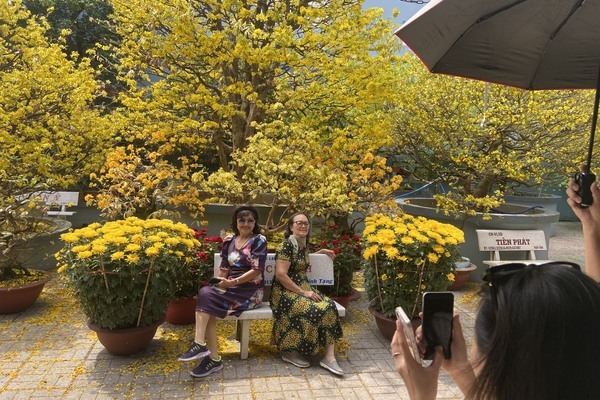The historic villages of Cao Lao Thuong and Cao Lao Trung have been united to form My Trach Commune, which is situated on the Son River's south bank. Cham people regained this area thousands of years ago. As a result of its historic roots, My Trach commune has a magical, fairy-like setting that includes banyan trees, river wharves and communal house roofs.
Century-old trees
 |
| A huge, rough tree root. |
As it is only found in a handful of settlements in My Trach, the old Diospyros decandra tree (aka Gold apple) is revered here.
The elders in the village who grew up in the hamlet recalled seeing trees in the yard as a youth, blossoming into a full-sized tree and producing fragrant, golden fruit around the full moon of the seventh lunar month each year.
Amid the shade of a 300-year-old canopy towering more than 30 meters high, Mr. Nguyen Trong Chien (87 years old) recalled: “This tree existed before I was born, approximately seven generations ago. At least one tree was planted in every house since in the past, it has provided sustenance for the hungry and helped us surmount many trials and tribulations.”
People pluck the fruit while it's still green and cook it with tree-toads to make a delectable meal. It is sold in the marketplaces of Ha Trach, Thanh Khe, and Ba Don when the fruit is ready (around lunar months 6-7). People can gauge a family's financial well-being each year by just glancing at whether or not the tree is loaded with fruits for sale.
The gold apple trees were a lifesaver for the residents of this area during the resistance war. The highest old trees in the community were used as vantage points from which to keep an eye on the invading forces.
 |
| Even though the inside of the tree's trunk is hollow, it is nevertheless robust. |
“Gongs ringing out from around the Diospyros decandra trees were a common sound back then, so much that the cattle plowing in the field rushed away fast once they heard it, without any human guidance,” a local resident said.
While pointing to the 300-year-old hamlet, Ms. Nguyen Thi Gai, the 90-year-old sister of Mr. Chien, said the original Diospyros decandra trees were once a refuge for her entire family. This plant has fibrous roots which fortified the cellar and the lush foliage protected those underneath during bombings by the enemies.
Specialty dish
People in My Trach, especially those who have been gone from their hometown for a long time, associate the village's ancient trees with a cuisine that was once a staple in their homeland's hard times but has since become a delicacy in its own right.
In March and April (lunar calendar), the trees produce green fruits with a acrid taste. Following rainstorms, the fields are full of toads. People caught them to cook with the fruits, creating an unexpectedly tasty dish that was passed down through the centuries and is today considered a delicacy.
 |
| Mrs. Gai said that in the past, the tree was her family's bunker. |
“It takes a long time to prepare this meal since after washing the toads, they must be diced well with other ingredients like onions, green peppers, and pepper... before being shaped into little balls and deep-fried until solid.
“Afterwards, chop up the green Diospyros decandra fruits and let them stew well with the toad meatballs by simmering until the water thickens. A sweet, aromatic, fatty taste will take its place in the meal at this point, with no fishy taste from the meat or bitter flavors of the green fruit. One bite of this food will leave a lasting impression,” said Nguyen Thi Xuan, a cook who frequently prepares this dish to send to the My Trach community in Ho Chi Minh City and Hanoi.
For a long time, when there were numerous toads around, this dish was a staple of their daily diets. Now since there are fewer giant toads, this meal has become something of a specialty, and those who want to eat it must order it around a week in advance, Ms Xuan said.
Ancient gold apple trees are being sought by many, but locals refuse o sell them even at expensive rates. They preserve the old trees as a reminder of the village's history. The tree has been designated a ‘historical tree’ by Nguyen Van Chien, since many of them are a few hundred years old.
 |
| Mr. Nguyen Trong Chien and a 300-year-old Diospyros decandra tree. |
My Trach Commune's People's Committee Chairman Mr. Phan Nam Tien said there are still 50 ancient Diospyros decandra trees in the community, with 20 of those trees hundreds of years old. People are also reminded by local authorities to take care of and maintain the historic trees on a regular basis.
Ancient trees in the area not only provide a pleasant atmosphere but also serve as a treasured historical artifact that connects generations of residents.
Hai Sam

An Giang has the oldest yellow apricot tree in Vietnam
People are flocking to a coffee shop on Nguyen Hoang Road in My Hoa Ward in Long Xuyen City in An Giang Province to admire a 200-year-old yellow apricot tree owned by Mr. Duong Tan Dung, 57.

Delicacy from Vietnam’s former capital
Vietnam’s ancient capital—has amassed a collection of tasty specialties. The steamed rice cake is one among them.